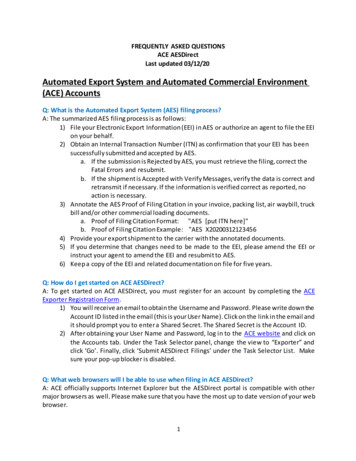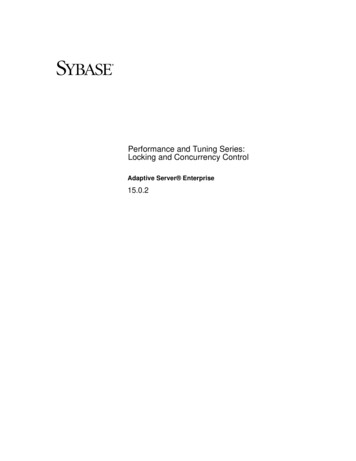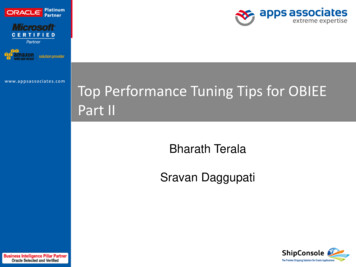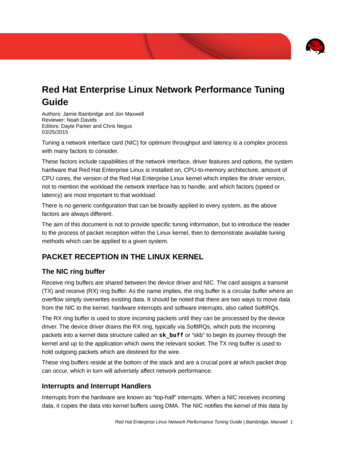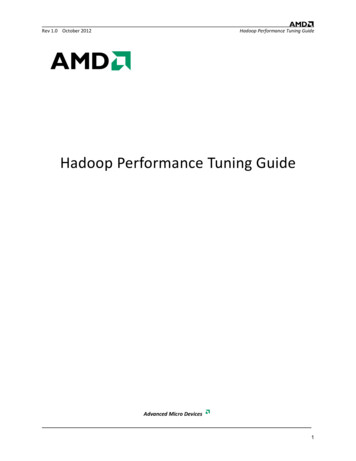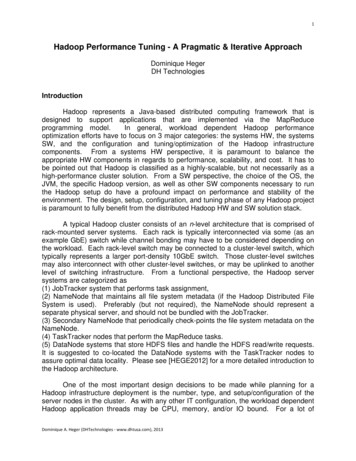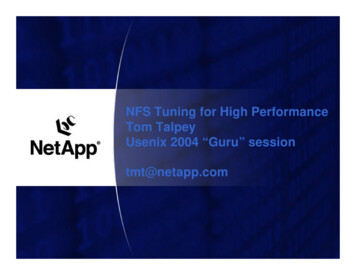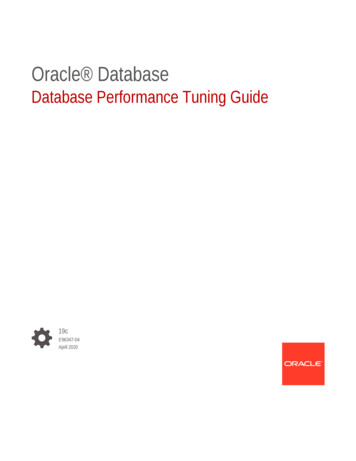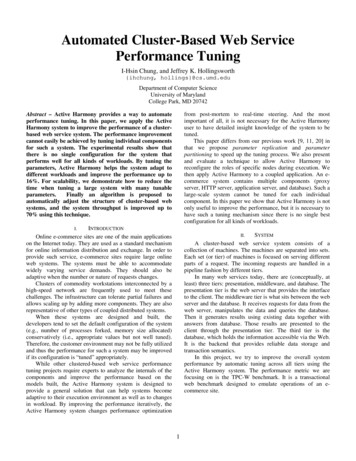
Transcription
Automated Cluster-Based Web ServicePerformance TuningI-Hsin Chung, and Jeffrey K. Hollingsworth{ihchung, hollings}@cs.umd.eduDepartment of Computer ScienceUniversity of MarylandCollege Park, MD 20742from post-mortem to real-time steering. And the mostimportant of all, it is not necessary for the Active Harmonyuser to have detailed insight knowledge of the system to betuned.This paper differs from our previous work [9, 11, 20] inthat we propose parameter replication and parameterpartitioning to speed up the tuning process. We also presentand evaluate a technique to allow Active Harmony toreconfigure the roles of specific nodes during execution. Wethen apply Active Harmony to a coupled application. An ecommerce system contains multiple components (proxyserver, HTTP server, application server, and database). Such alarge-scale system cannot be tuned for each individualcomponent. In this paper we show that Active Harmony is notonly useful to improve the performance, but it is necessary tohave such a tuning mechanism since there is no single bestconfiguration for all kinds of workloads.Abstract – Active Harmony provides a way to automateperformance tuning. In this paper, we apply the ActiveHarmony system to improve the performance of a clusterbased web service system. The performance improvementcannot easily be achieved by tuning individual componentsfor such a system. The experimental results show thatthere is no single configuration for the system thatperforms well for all kinds of workloads. By tuning theparameters, Active Harmony helps the system adapt todifferent workloads and improve the performance up to16%. For scalability, we demonstrate how to reduce thetime when tuning a large system with many tunableparameters.Finally an algorithm is proposed toautomatically adjust the structure of cluster-based websystems, and the system throughput is improved up to70% using this technique.INTRODUCTIONOnline e-commerce sites are one of the main applicationson the Internet today. They are used as a standard mechanismfor online information distribution and exchange. In order toprovide such service, e-commerce sites require large onlineweb systems. The systems must be able to accommodatewidely varying service demands. They should also beadaptive when the number or nature of requests changes.Clusters of commodity workstations interconnected by ahigh-speed network are frequently used to meet thesechallenges. The infrastructure can tolerate partial failures andallows scaling up by adding more components. They are alsorepresentative of other types of coupled distributed systems.When these systems are designed and built, thedevelopers tend to set the default configuration of the system(e.g., number of processes forked, memory size allocated)conservatively (i.e., appropriate values but not well tuned).Therefore, the customer environment may not be fully utilizedand thus the performance for such a system may be improvedif its configuration is “tuned” appropriately.While other clustered-based web service performancetuning projects require experts to analyze the internals of thecomponents and improve the performance based on themodels built, the Active Harmony system is designed toprovide a general solution that can help systems becomeadaptive to their execution environment as well as to changesin workload. By improving the performance iteratively, theActive Harmony system changes performance optimizationI.SYSTEMA cluster-based web service system consists of acollection of machines. The machines are separated into sets.Each set (or tier) of machines is focused on serving differentparts of a request. The incoming requests are handled in apipeline fashion by different tiers.In many web services today, there are (conceptually, atleast) three tiers: presentation, middleware, and database. Thepresentation tier is the web server that provides the interfaceto the client. The middleware tier is what sits between the webserver and the database. It receives requests for data from theweb server, manipulates the data and queries the database.Then it generates results using existing data together withanswers from database. Those results are presented to theclient through the presentation tier. The third tier is thedatabase, which holds the information accessible via the Web.It is the backend that provides reliable data storage andtransaction semantics.In this project, we try to improve the overall systemperformance by automatic tuning across all tiers using theActive Harmony system. The performance metric we arefocusing on is the TPC-W benchmark. It is a transactionalweb benchmark designed to emulate operations of an ecommerce site.II.1
Active HarmonyTo provide automatic performance tuning, we developedthe Active Harmony system [9, 11, 20]. Active Harmony is aninfrastructure that allows applications to become tunable byapplying very minimal changes to the application and librarysource code. This adaptability provides applications with away to improve performance during a single execution basedon the observed performance. The types of things that can betuned at runtime range from parameters such as the size of aread-ahead parameter to what algorithm is being used (e.g.,heap sort vs. quick-sort).Figure 1 shows the Active Harmony automated runtimetuning system. The Library Specification Layer provides auniform API to library users by integrating different librarieswith the same or similar functionality.The Adaptation Controller is the main part of theHarmony server. The Adaptability component manages thevalues of the different tunable parameters provided by theapplications and changes them for better performance.from the nearest integer point in the space to approximate theperformance at the selected point in the continuous space.A.B.TPC-W BenchmarkThe major workload we use when tuning the clusterbased web service is the TPC-W benchmark. The TPC-W is atransactional web benchmark designed to mimic operations ofan e-commerce site. The workload explores a breadth ofsystem components together with the execution environment.Like all other TPC benchmarks, the TPC-W benchmarkspecification is a written document which defines how tosetup, execute, and document a TPC-W benchmark run.TABLE 1: TPC-W BENCHMARK WORKLOADSWeb InteractionBrowseHomeNew ProductsBest SellersProduct DetailSearch RequestSearch ResultsOrderShopping CartApplicationHarmony ServerApplication Programming InterfaceLibrarySpecificationLayerLibrary 1Parameter(s)MonitoringComponentLibrary 2Parameter(s)Customer RegistrationAdaptationControllerBuy RequestBuy ConfirmOrder InquiryOrder DisplayAdmin RequestAdmin ConfirmLibrary n Parameter(s)Browsing(WIPSb)95 %29.00 %11.00 %11.00 %21.00 %12.00 %11.00 %5%2.00 %0.82 %0.75 %0.69 %0.30 %0.25 %0.10 %0.09 %Shopping(WIPS)80 %16.00 %5.00 %5.00 %17.00 %20.00 %17.00 %20 %11.60 %3.00 %2.60 %1.20 %0.75 %0.66 %0.10 %0.09 %Ordering(WIPSo)50 %9.12 %0.46 %0.46 %12.35 %14.53 %13.08 %50 %13.53 %12.86 %12.73 %10.18 %0.25 %0.22 %0.12 %0.11 %System (Execution Environment)The two primary performance metrics of the TPC-Wbenchmark are the number of Web Interaction Per Second(WIPS), and a price performance metric defined asDollars/WIPS. However, some shopping applications attractusers primarily interested in browsing, while others attractthose planning to purchase. Two secondary metrics aredefined to provide insight as to how a particular system willperform under these conditions. WIPSb is used to refer to theaverage number of Web Interaction Per Second completedduring the Browsing Interval. WIPSo is used to refer to theaverage number of Web Interaction Per Second completedduring the Ordering Interval.The TPC-W workload is made up of a set of webinteractions. Different workloads assign different relativeweights to each of the web interactions based on the scenario.In general, these web interactions can be classified as either“Browse” or “Order” depending on whether they involvebrowsing and searching on the site or whether they play anexplicit role in the ordering process. The details for eachworkload breakdown are shown in the Table 1.Figure 1: Active Harmony automated tuning systemThe kernel of the adaptation controller is a tuningalgorithm. The algorithm is based on the simplex method forfinding a function's minimum value [14]. In the ActiveHarmony system, we treat each tunable parameter as avariable in an independent dimension. The algorithm makesuse of a simplex, which is a geometrical figure defined by k 1connected points in a k-dimensions space. In 2-dimensions,the simplex is a triangle, and for 3-d space the simplex is anon-degenerated tetrahedron.The Nelder-Mead simplex method approximates theextreme of a function by considering the worst point of thesimplex and forming its symmetrical image through the centerof the opposite (hyper) face. At each step a better pointreplaces the worst points and thus moves the simplex towardsthe extreme, in our case towards the minimum.The algorithm described above assumes a well-definedfunction and works in a continuous space. However, neitherof these assumptions holds in our situation. Thus we haveadapted the algorithm by simply using the resulting values2
“iteration” 1 . The Active Harmony server will adjust theconfiguration (parameters values) between two iterations.Figure 2 shows that for different workloads, the systemshould apply different configurations. Each different barrepresents the best configurations we determined after 200tuning iterations for each of the workloads. We then applythose best configurations to the other two workloads forcomparison. The results show that when using a configurationthat is tuned for another workload, the system does notperform as well as using a configuration that is tuned for thecurrent workload. The results show that there is no universalconfiguration good for all kinds of workloads. The table inFigure 2 shows the improvements for those best-tunedconfigurations compared to the default configuration. Theimprovements range from 5% to 16%.C.EnvironmentThe summary of the environment used for our experimentis shown in Table 2. The 10 machines used include the onesrunning emulated browsers and the servers for proxy, HTTP,application and database services. Each machine is equippedwith dual processors, 1 Gbyte memory and runs Linux as theoperating system. For each tier, we select Squid as the proxyserver, Tomcat as the HTTP & application server and MySQLas the database server. All computer software components areopen-source which allows us to look at source code tounderstand system performance. The TPC-W benchmarkversion we chose simulates a store that sells approximately10,000 items.TABLE 2: EXPERIMENT ENVIRONMENTHardwarePerformance (WIPS)Dual AMD Athlon 1.67 GHz1Gbyte100Mbps Ethernet10ProcessorMemoryNetworkNo. of machinesSoftwareOperating SystemTPC-W benchmarkProxy ServerHTTP & Application ServerDatabase ServerLinux 2.4.18smpModified from the PHARM [6]Squid 2.5 [3]Tomcat 4.0.4 [1]MySQL 3.23.51 [2]6050403020100BrowsingShoppingOrderingWorkload AppliedTUNINGOur goal is to improve the overall system performanceusing Active Harmony. We first show that there is no singleconfiguration suitable for all the workloads. Active Harmonymakes the system perform better by using differentconfigurations when facing different workloads. Then weinvestigate Active Harmony’s scalability as the number ofmachines grows. One way to solve this problem is to partitionthe parameters into sets. We show how to use an independentActive Harmony tuning server for each set to speed up thetuning process. Another method is to tune a representative setof parameters and use duplicated values on the rest of nodes.In Section four, we also show how to adjust the number ofnodes in each tier dynamically to reduce hot spots.III.Best configuration for BrowsingBest configuration for ShoppingBest configuration for OrderingOriginal configurationBest configuration after 200 iterationsBrowsing ShoppingOrderingImprovementcompared to thedefault configuration15%16%5%Figure 2: Applying best configuration after 200 iterations to differentworkloadsTable 3 shows the details of all Harmony tunableparameters before, and after tuning for each of the workloads.The results show for the proxy server, it first increases themain memory size for the cache to improve the performance.For the shopping and ordering workloads, the proxy servertries to cache larger objects in the memory compared to thebrowsing workload. For the HTTP server (which is part of theapplication server), the tuning results show that it spawnsmore threads to handle the requests during the orderingworkload. We believe the main reason is that most of therequests in the ordering workload require high latencyoperations in the database server (i.e., performing updateA.Impact of Varying WorkloadIn this experiment we show that the Active Harmonyserver can tune the system to adjust each tier’s server toprovide good performance. We use four machines in thisexperiment: one machine for the emulated browsers, one forthe proxy server, one for the HTTP & application server, andone for the database server.In the experiment, we examine the tuning processes fortwo different workloads: browsing and ordering. Both tuningprocesses are started using the default configuration. We thenlet the system warm up for 100 seconds and measure theperformance (WIPS) for 1000 seconds followed by 100seconds for cooling down. We define such a cycle as one1The 1,200 second-iteration is TPC-W benchmark compliance (i.e., specifiedin the TPC-W documentation). The iteration timescale can be as short as 30seconds according to our experiment experience.3
transactions on the database). Thus the average response timeis longer compared to other workloads. As long as it is notover the system capacity, the HTTP server should use morethreads (minProcessors/maxProcessors) and buffer space(bufferSize) to handle the incoming requests. The waitingqueue capacity should also increase accordingly (acceptCount)as the results show. The same situation happens in the workerpart (AJP connector) of the application server. For thedatabase server, the tuning results show it increases the cacheand buffer size when the utilization for the database is high(i.e., shopping and ordering workloads). However, it showsthat reducing the join buffer size does not impact performance.From the results we can see that some parameterssignificantly affect the overall system performance such as thenumber of threads or the buffer size. However, there are someparameters that we thought to be performance related but theyturn out not to be important. For example, the thresholds(cache swap low, cache swap high) which control whetherthe proxy server should swap out objects do not impact theoverall system performance. Since it is automated, the ActiveHarmony tuning process is also helpful for systemadministrators and developers to identify those parameters thatactually affect system performance. We plan to further addressthis issue by prioritizing the importance of parameters in ourfuture work.process lengthy and the tuning results may not be useful sincethe environment could change during the tuning process.In the original Active Harmony system, to tune nparameters at once requires exploring n 1 configurationsbefore improvements to the system will take effect. If thereare numerous servers in the cluster and each server containstens of parameters, the tuning process will be fairly long. Inorder to reduce the initial exploration period, we partition thecomponents inside the cluster into groups and use separateActive Harmony tuning servers for each groups. There areseveral ways to group servers.When all the machines in the same tier are homogeneous,we try to partition all the servers into tuning groups using twomethods. The first one is parameter duplication: we only tuneone server for each tier, and the values for those parametersare duplicated to other servers in the same tier. This tuningmechanism is based on the assumptions that (a) servers in thesame tier will have the same or similar behavior for the sameconfiguration; (b) the workload is evenly distributed amongall the servers in the same tier.The second way to group nodes, parameter partitioning,is based on a static work line. Each work line group consistsof at least one server from each tier. A request to the webcluster system is only handled by exactly one work line group.In other words, any server in work line group A will notgenerate (serve) requests to (from) a server in work line groupB. We use a different Active Harmony tuning server to tunethe parameters for each work line. The assumption for thistuning mechanism is that (a) all the work lines are running inparallel; and (b) there is no interaction between any two of thework lines.Both of these approaches to grouping nodes require somedomain knowledge about the role of each node. However,grouping of nodes could easily be exported to ActiveHarmony as part of the tuning API.To compare these two approaches, we tuned the systemusing three different tuning methods: default, parameterduplication and parameter partitioning.TABLE 3: TUNING RESULTS FOR DIFFERENT WORKLOADSBest configuration after 200DefaultTunable parametersiterationsconfig.Browsing ShoppingOrderingProxy Servercache mem8131721cache swap low90918691cache swap high95969696maximum object size4,0964,0964,0965,888minimum object size0050306maximum object862562,560size in memorystore objects per201525105bucketHTTP & App. cceptCount1076306671Database Serverbinlog cache size32,76863,488153,600284,672Delayed insert limit100200400700max connections100201451701delayed queue size10002,6009,1007,1008,388,600Join buffer size407,552407,552407,552Net buffer length16,38431,74438,91234,816table cache64873905761thread con10819176thread stack65,535102,400 1,018,880773,120TABLE 4: PERFORMANCE FOR DIFFERENT METHODS FOR CLUSTER d(Std. Dev.)3 8(9.7)19.0%107Table 4 shows the tuning results. The results for all threemethods are very close. The default method takes the longesttime since there are many parameters and only oneB.Cluster TuningWhen the number of servers increases, the number oftunable parameters also increases. This makes the tuning234Performance for the best configuration after 200 iterationsFor the second 100 iterations
//decide the priority for the nodes to be relievedperformance result per iteration. The parameter duplicationmethod provides both a larger performance improvement andfaster convergence to the tuned configuration. It speeds up thetuning process since the tunable parameters are distributed tomultiple tuning servers and there are fewer parameters foreach tuning server to tune. The time (iterations) spent for thegrouping by parameter partitioning method is about 2/3 of thedefault method.Based on the time for the tuning process, parameterduplication tuning seems to be the best. It takes a muchshorter time for tuning. However, if stable performanceduring the tuning process is critical, parameter partitioning bywork lines is a reasonable choice.In the future, we plan to investigate hybrid tuning usingthe parameter duplication method first, and then using aseparate tuning server for each group for fine-granularitytuning.4. Let i Head(L1), find the node k in L2 such that satisfies(a)(b)(c)//find out the appropriate node to be reconfigured(a) Tier(i) Tier(k)(b) M(Tier(k)) 1(c) F Nk Mkm – Nk Ak is minimal, where k mand Tier(k) Tier(m)5. Reconfigure k such that Tier(i) Tier(k)Figure 3: Reconfiguration algorithm for external tuningThe Acti
performance tuning. In this paper, we apply the Active Harmony system to improve the performance of a cluster-based web service system. The performance improvement cannot easily be achieved by tuning individual components for such a system. The experimental results show
